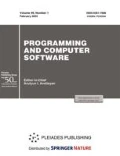Abstract
This paper describes an approach to testing artificial neural networks that is implemented in a C++ program as a set of data structures and algorithms for their processing. C++ classes are used as data structures that implement the processing of the following objects: vertex, edge, directed and undirected graphs, spanning tree, and circuit. Interfaces for the most important overloaded operations on these objects are described. The implementation of a testing procedure that uses overloaded operations on graph model objects is illustrated.












Similar content being viewed by others
REFERENCES
Ciresan, D., Meier, U., Masci, J., and Schmidhuber, J., Multi-column deep neural network for traffic sign classification, Neural Networks, 2012, vol. 12, pp. 333–338.
Talbot, D., CES 2015: Nvidia demos a car computer trained with “deep learning,” MIT Technol. Rev., 2015. https://www.technologyreview.com/s/533936/ces-2015-nvidia-demos-a-car-computer-trained-with-deep-learning.
Roth, S., Shrinkage fields for effective image restoration, Proc. IEEE Conf. Computer Vision and Pattern Recognition (CVPR), 2014, pp. 2774–2781.
Deng, L. and Yu, D., Deep learning: Methods and applications, Found. Trends Signal Process., 2014, vol. 7, nos. 3–4, pp. 1–19.
Karpov, Yu.L., Karpov, L.E., and Smetanin, Yu.G., Adaptation of general concepts of software testing to neural networks, Program. Comput. Software, 2018, vol. 44, no. 5, pp. 324–334. https://doi.org/10.1134/S0361768818050031
Rosenblatt, F., Principles of Neurodynamics: Perceptrons and the Theory of Brain Mechanisms, Washington: Spartan Books, 1961.
Kohonen, T., Self-Organization and Associative Memory, New York: Springer, 1984.
Grossberg, S., Nonlinear neural networks: Principles, mechanisms, and architectures, Neural Networks, 1988, vol. 1, no. 1. pp. 17–61.
Hebb, D.O., The Organization of Behavior, New York: Wiley, 1948.
Harary, F., Graph Theory, Addison Wesley, 1969.
Ore, O., Theory of graphs, Amer. Math. Soc. Trans., 1962.
Iordanskii, M.A., Konstruktivnaya teoriya grafov i ee prilozheniya (Constructive Graph Theory and Its Applications), Izd. Kirillitsa, 2016.
Hopfield, J.J., Neural networks and physical systems with emergent collective computational abilities, Proc. Natl. Acad. Sci. U. S. A., 1982, vol. 79, no. 8, pp. 2554–2558.
Hinton, D.E. and Seinowski, T., Optimal perceptual inference, Proc. IEEE Conf. Computer Vision and Pattern Recognition, 1983, pp. 448–453.
Aracena, J., Demongeot, J., and Goles, E., Positive and negative circuits in discrete neural networks, IEEE Trans. Neural Networks, 2004, vol. 15, no. 1, pp. 77–83.
Karpov, Yu.L., Karpov, L.E., and Smetanin, Yu.G., Elimination of negative circuits in certain neural network structures to achieve stable solutions, Program. Comput. Software, 2019, vol. 45, no. 5, pp. 241–250. https://doi.org/10.1134/S0361768819050025
ACKNOWLEDGMENTS
We are grateful to Viktor Vasilyevich Malyshko, Associate Professor at the System Programming Department of the Faculty of Computational Mathematics and Cybernetics (CMC), Moscow State University, who assisted in verifying and refining the class diagram of the graph model.
Funding
This work was supported by the Russian Foundation for Basic Research, project nos. 18-07-0697-a, 18-07-01211-a, 19-07-00321-a, and 19-07-00493-a.
Author information
Authors and Affiliations
Corresponding authors
Additional information
Not long before this publication, one of the co-authors of our work, Yurii Gennad’evich Smetanin, untimely passed away.
We shall always remember him as our friend, a true scientist, and a very good person.
Translated by Yu. Kornienko
Rights and permissions
About this article
Cite this article
Karpov, Y.L., Volkova, I.A., Vylitok, A.A. et al. Designing Interfaces for Classes of a Neural Network Graph Model. Program Comput Soft 46, 463–472 (2020). https://doi.org/10.1134/S036176882007004X
Received:
Revised:
Accepted:
Published:
Issue Date:
DOI: https://doi.org/10.1134/S036176882007004X




